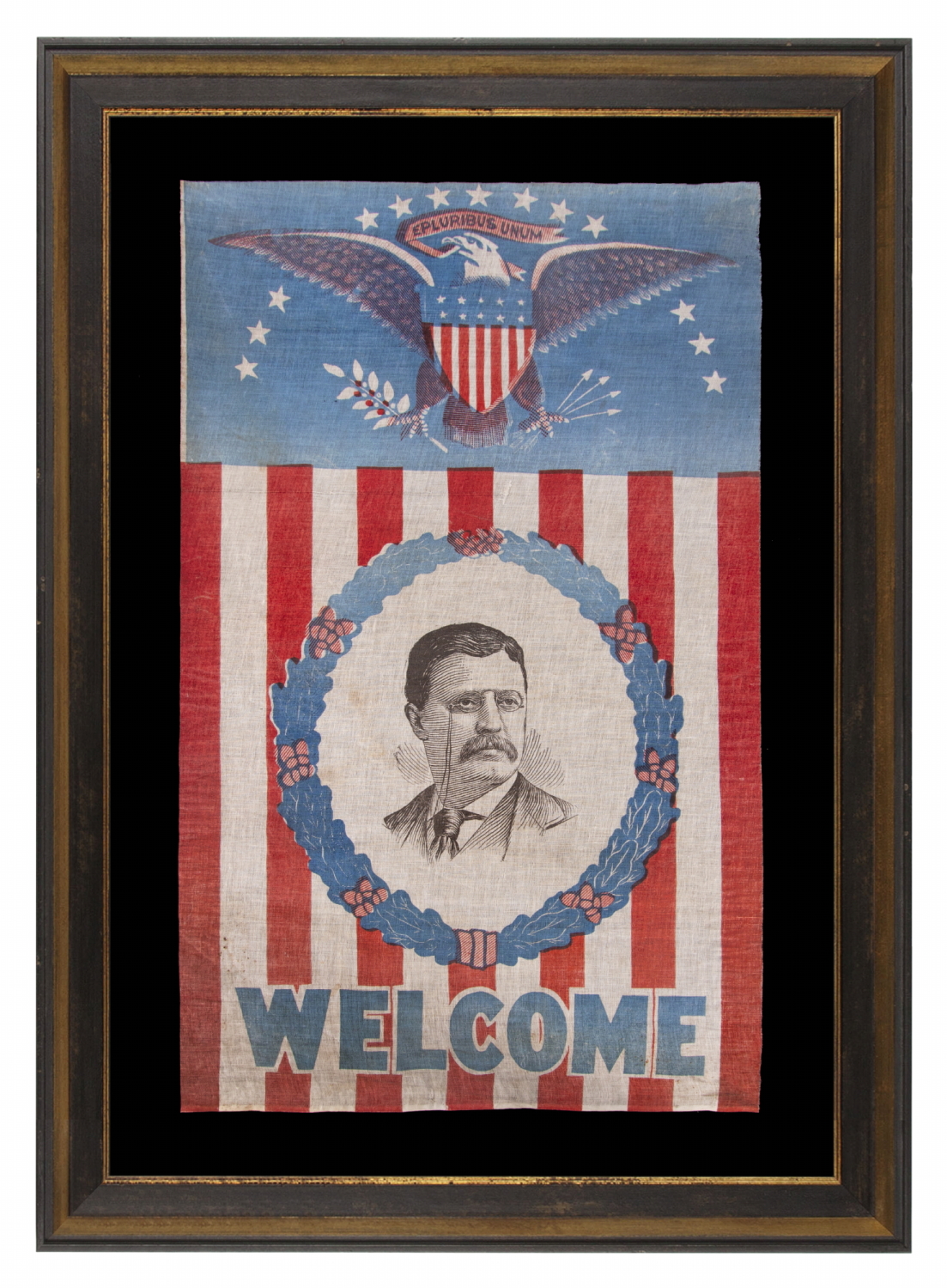
| |
EXCEPTIONAL PARADE FLAG STYLE BANNER, WITH A LARGE EAGLE AND 13 STARS ABOVE A PORTRAIT OF THEODORE ROOSEVELT, SET WITHIN A RING OF OAK LEAVES & ACORNS; MADE FOR HIS 1912 PRESIDENTIAL CAMPAIGN |
|
| Available: |
Sold |
| Frame Size (H x L): |
Approx. 47" x 34" |
| Flag Size (H x L): |
35" x 21.75" |
|
| Description....: |
|
Vertical format patriotic parade flag/banner, printed on coarse, glazed cotton, with a handsome portrait image of Teddy Roosevelt, set within an oval wreath of oak leaves and acorns against a field of vertical red and white stripes. A wide blue register above features a large federal eagle, bearing the usual olive branch and arrows in its talons, amid an arch of 13 stars. Beneath TR's image, in bold block letters, is the word "Welcome".
Made for his 1912 campaign for the presidency, when he ran on the Bull Moose / Progressive Party ticket, this graphically balanced and colorful textile displays a handsome image of one of our nation’s most beloved leaders, and is one of the most striking parade banners of its kind. Another version of this banner exists, but with Roosevelt's image replaced by that of President William Howard Taft. In 1908, after serving nearly two full terms in office, Teddy Roosevelt tapped Taft as his Republican Party successor. Stepping down, Taft became the Republican presidential candidate, going on to defeat three-time, Democrat nominee, William Jennings Bryan in the 1908 election.
Roosevelt, who vowed to never run again, changed his mind in 1912, throwing his hat in the ring as an independent against the incumbent, Taft and Democrat Woodrow Wilson. Though he won more votes than any third party candidate in American history, and beat Taft, he lost the election and thus the White House for not only himself, but his former party. This gave the reins to Wilson, who became the only the second Democrat to win the presidency following the Civil War.*
The existence of the Taft version of this banner allows accurate dating of the Roosevelt textile to 1912.
One should note how these banners are modifications of the Stars & Stripes, instead of a national flag. As the 20th century neared, flag ethics began to emerge that would affect the use of the Stars & Stripes for the purpose of advertising. The practice of printing candidates’ names and faces directly on the flag had been employed liberally since 1840. In the 1880's, however, booklets began to appear, issued mostly by insurance companies, patriotic organizations, and veteran’s groups, that spelled out rules thought to be prudent regarding use and display of our nation's flag. It was at this time that public sentiment began to lean toward treatment of the flag as a sacred object. Bills governing flag desecration passed the U.S. House of Representatives in 1890, and the U.S. Senate in both 1904 and 1908, but were not at the time adopted into law. By 1905, however, 34 of the 45 states had passed their own laws regarding flag use.
This textile is an excellent representation of the departure from the practice of printing names and faces of political candidates directly onto the American national flag. Use of various combinations of stars, stripes, eagles, shields, etc., were still perfectly acceptable.
An example of this banner is documented in in "Threads of History: Americana Recorded on Cloth, 1775 to the Present," by Herbert Ridgeway Collins (1979, Smithsonian Press), as item 949 on p. 376. It of interest to note that a similar version is known. In the same scale, it bears the same blue register, eagle, and striped backdrop as the 1912 Roosevelt version, but employs a different portrait and rectangular, red, white, and blue bordered window, in place of the oak wreath.
* Democrat Grover Cleveland won twice, in 1884 and 1892, serving two non-consecutive terms.
Mounting: The textile has been mounted and framed within our own conservation department, which is led by expert staff. We take great care in the mounting and preservation of flags and have framed thousands of examples.
The textile has been hand-stitched to 100% cotton, black in color, that was washed and treated for colorfastness. The mount was then placed in a black-painted, hand-gilded and distressed Italian molding. The glazing is U.V. protective acrylic.
Condition: The condition is exceptional for the period. There is very minor soiling along and near the bottom, accompanied by small scatterings of tiny stains, above and to the left of, and below and to the right of the word “Welcome.” There are some very minor stains in the oval window. There is very minor fading. |
|
|
|
| Collector Level: |
Flags for the truest Patriots. My best offerings |
|
| Flag Type: |
Parade flag |
|
| Star Count: |
13 |
|
| Earliest Date of Origin: |
1912 |
|
| Latest Date of Origin: |
1912 |
|
| State/Affiliation: |
13 Original Colonies |
|
| War Association: |
|
|
| Price: |
SOLD |
|
| |
Views: 530 |
|
|
|

